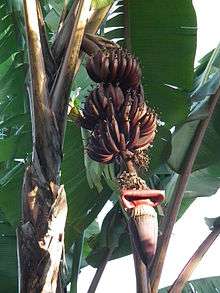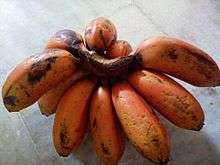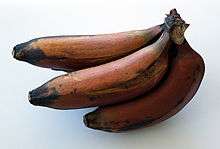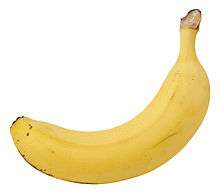Red banana
Red bananas are a group of varieties of banana with reddish-purple skin. Some are smaller and plumper than the common Cavendish banana, others much larger. When ripe, raw red bananas have a flesh that is cream to light pink in color. They are also softer and sweeter than the yellow Cavendish varieties, some with a slight raspberry flavor and others with an earthy one. Many red bananas are exported by producers in East Africa, Asia, South America and the United Arab Emirates. They are a favorite in Central America but are sold throughout the world.
| Musa acuminata 'Red Dacca' | |
|---|---|
 Red banana plant from Tanzania showing fruits and inflorescence. | |
| Species | Musa acuminata |
| Cultivar group | AAA Group |
| Cultivar | 'Red Dacca' |
| Origin | South East Asia |
_'Red_Dacca'_-_red_banana.jpg)
Taxonomy and nomenclature
The red banana is a triploid cultivar of the wild banana Musa acuminata, belonging to the AAA group.[1]
Its official designation is Musa acuminata (AAA Group) 'Red Dacca'.[2][3]
Synonyms include:
- Musa acuminata Colla (AAA Group) cv. 'Red'
- Musa sapientum L. f. rubra Bail.
- Musa sapientum L. var. rubra (Firm.) Baker
- Musa rubra Wall. ex Kurz.
- Musa × paradisiaca L. ssp. sapientum (L.) Kuntze var. rubra
 Red banana From Tamil Nadu
Red banana From Tamil Nadu - Musa acuminata Colla (AAA Group) cv. 'Cuban Red'
- Musa acuminata Colla (Cavendish Group) cv. 'Cuban Red'
- Musa acuminata Colla (AAA Group) cv. 'Red Jamaican'
- Musa acuminata Colla (AAA Group) cv. 'Jamaican Red'
- Musa acuminata Colla (AAA Group) cv. 'Spanish Red'.
It is known in English as Red dacca (Australia), Red banana, 'Red' banana (USA), Claret banana, Cavendish banana "Cuban Red", Jamaican red banana, and Red Cavendish banana. It is also known under a variety of common names in other countries, including the following:
- Bengali: Ognisagor kola (অগ্নিসাগর কলা)
- Bulgarian: Cherven banan (Червен банан)
- Burmese: Shwe nget pyaw.
- Chinese: Hong guo jiao (紅果蕉)
- Danish: Kubabanan, Æblebanan, Rød banan.
- Dutch: Rode banaan, Cubabanaan.
- French: Figue rose (Guadeloupe, Martinique), Figue rouge (Haiti), Figue rouge-vin, Figue violette (Guadeloupe), Bacove violette (French Guiana), Banane rouge, Banane violette, Banane de Cuba
- German: Weinrote Banane, Kuba Banane
- Greek: Kōkkini banāna (Κόκκινη μπανάνα)
- Hindi: Lāl kélā (लाल केला)
- Indonesia: Pisang Susu Merah
- Italian: Banana rosa, Banana di Cuba
- Japanese: Akai banana (赤いバナナ)
- Korean: Bbalgan banana (빨간 바나나)
- Nepalese : Rato kera (रातो केरा)
- Malaysian: Pisang raja udang
- Portuguese: Banana roxa (Brazil), Bananeira roxa, Banana vermelha
- Polish: Czerwony banan
- Romanian: Banană roşie
- Russian: Krasniy banan (красный банан)
- Sinhalese: Rathambala (රතඹලා)
- Spanish: Banana roja (Argentina), Banano color clarete, tafetán (Colombia), Tafetán morado (Colombia), Plátano morado (Cuba), Guineo colorado (Puerto Rico), Plátano colorado, Plátano rosado (Ecuador), Plátano rojo (Perú)
- Tagalog: Morado, Raines na pula, or Gloria[4]
- Tamil: Sevvazhai (செவ்வாழை)
- Thai: Kluay nak กล้วยนาก
- Malayalam: Chovazha, Chenkadali (ചെങ്കദളി), Kappa Pazham
- Sanskrit : Raktakadali (रक्तकदली)
- Kannada : chandrabALe (ಚಂದ್ರಬಾಳೆ)
- Sranantongo (Suriname): Ingibakba (Indiaanen banaan/Amerindian banana)
Description

Red bananas should have a deep red or maroon rind when ripe, and are best eaten when unbruised and slightly soft. This variety contains more beta carotene and vitamin C than yellow bananas. It also contains potassium and iron. The redder the fruit, the more carotene and the higher the vitamin C level.[5] As with yellow bananas, red bananas will ripen in a few days at room temperature and are best stored outside from refrigeration.
Compared with the most popular banana, the Cavendish (Yellow) banana, they tend to be smaller, have a much thicker skin (with less banana inside), with a reduced taste, but do have a longer shelf life than yellow bananas. They tend to cost about 50% more per pound than yellow bananas, just because there is a much smaller supply of them.
Uses
Red bananas are eaten in the same way as yellow bananas, by peeling the fruit before eating. They are frequently eaten raw, whole or chopped, and added to desserts and fruit salads, but can also be baked, fried, and toasted. Red bananas are also commonly sold dried in stores.
The red banana has more beta carotene and vitamin C than yellow banana varieties. All bananas contain natural sources of three sugars: sucrose, fructose, and glucose.
The first bananas to appear on the market in Toronto (in the 1870s and 1880s) were red bananas.[6] Red bananas are available year round at specialty markets and larger supermarkets in the United States.
Diseases
See also
References
- Michel H. Porcher; Prof. Snow Barlow (2002-07-19). "Sorting Musa names". The University of Melbourne. Retrieved 11 January 2011.
- T.K., Lim. "Edible Medicinal And Non Medicinal Plants: Volume 3, Fruits". Springer Science & Business Media, 2012. Retrieved 12 January 2020.
- "Banana Varieties". Growables. Retrieved 12 January 2020.
- http://www.pepper.ph/go-bananas-11-varieties-worth-seeking-philippines/
- "Red Bananas Fruit Profile". Chiquita Bananas.
- John V McAree (1953) The Cabbagetown Store (Toronto: Ryerson Press) p. 19.
- Encanto Farms: Red Dacca
